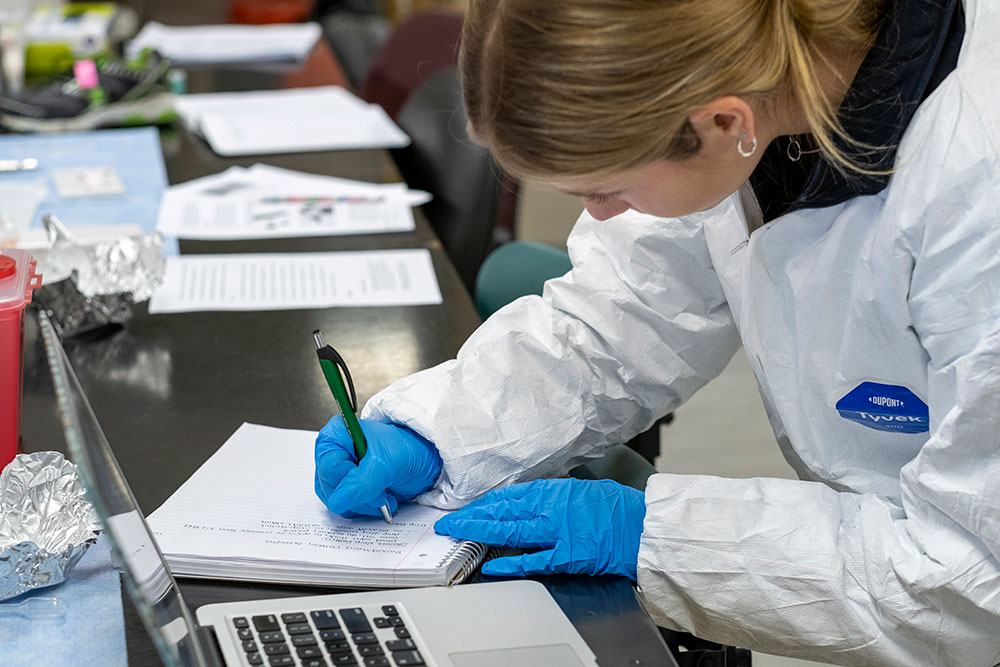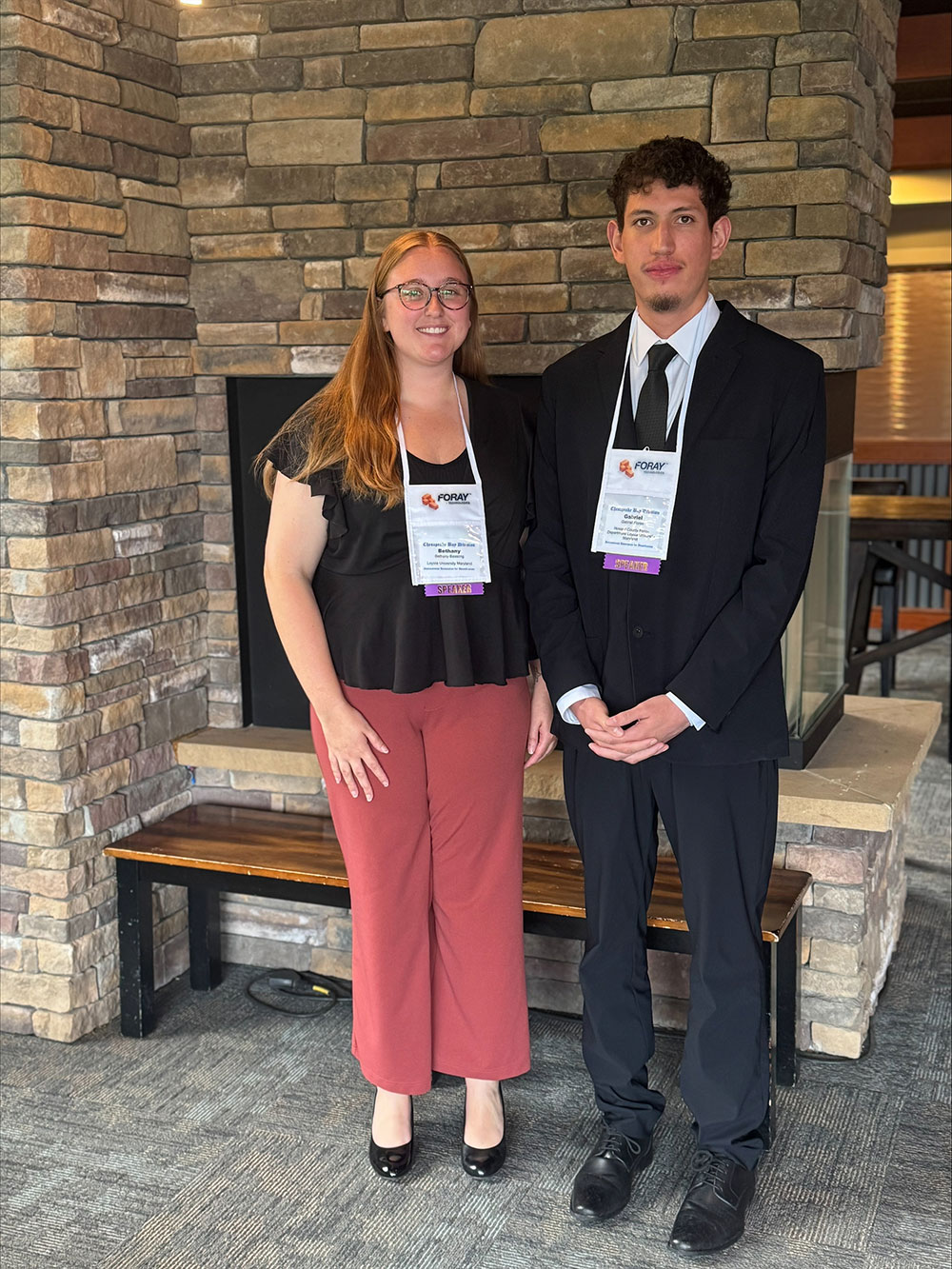Loyola forensic science students help Howard County Police identify victim in county's oldest cold case

Loyola forensic science students played a pivotal role in helping to identify a woman whose identity has been a mystery since her death in 1971.
As interns for the Howard County Police Department, the students documented and digitized evidence, reevaluated fingerprints from more than 50 years ago, and leveraged genealogy and AI technology. As a result, police were able to identify the woman as Sadie Belle Murray, born Sept. 7, 1924, in Pennsylvania, who at the time of her death in 1971 went by Sarah Belle Sharkey.
The Jane Doe case was the county’s oldest cold case homicide.
Howard County Police announced the identification in September 2025, which not only solved the 54-year-old mystery of Sharkey’s identity, but also reunited two of her surviving adult children, who had been unaware of what had happened to their mother.
Bringing a Family Closure
Bethany Bessling, ’25, worked on the case as an intern with Howard County Police in Fall 2024. A psychology and forensic science double major, she is currently enrolled in Loyola’s Master of Science in Forensic Pattern Analysis program and aspires to work in a crime lab for a government agency. The opportunity to apply the knowledge and skills she had learned in the classroom to make a positive impact was a deeply meaningful experience.
“I wish I could put into words how it feels. It’s surreal,” Bessling said. “Something really unfortunate and sad happened to this family. It was truly rewarding to be able to give them some type of information and closure.”
During her internship, Bessling reported to cold case detective Cpl. Wade Zufall, who oversees the program. Now in his 24th year in law enforcement, Zufall first connected with Loyola’s forensic science department after a colleague introduced him to David Rivers, Ph.D., chair and professor of forensic science.
“It’s really blossomed into a great partnership between our department and Loyola,” said Zufall. “It evolved from me helping a student with a project, to guest speaking for professors in forensic science, to creating this internship where Loyola student interns are now helping on some of these cold cases.”
Bessling’s work included sending fingerprints to every state police department in the country to see if a connection had been missed over the decades.
She also used Photoshop to generate an AI rendering of Sharkey in the hope that someone might recognize her and helped organize and digitize old case files. Bessling contacted NamUs, the National Missing and Unidentified Persons System, to collect artist renderings that could enhance the Photoshop rendering.
Partners in Solving Crime
Using modern technology to look at an old case through a new lens, collaborating with other police departments, and documenting evidence is exactly the type of real-world experience Zufall wants interns to gain during their time with Howard County Police.
“It’s something that’s unmatched. It’s not something that I know about going on at any other department in our area,” he said of the experiential learning element. “Sometimes interns are just doing clerical work. We actually put our interns in a leadership position, actively working on aspects of the case.”
Several Loyola students assisted with the case, including Julia Viveiros, ’24, who was the first to participate in the internship. After graduating, she returned to Howard County Police as a non-sworn contingent worker assisting with cold cases.
Gabriel Flores, ’25, worked on the case at the same time as Bessling. One morning, Zufall mentioned to Flores that solving the case would require testing old histology slides for DNA and using forensic genealogy—an expensive process. The unit captain overheard and escalated the idea to Chief of Police Gregory Der, who approved the resources.
“That whole process of doing the DNA profile and forensic genealogy happened just because Gabe and I were having a discussion one morning,” Zufall said. “I think that’s pretty amazing.”
Linking the Past to the Present
Identifying the victim in this case was only possible because the police still had DNA samples from when Sharkey was first found.
“Wade had used genealogy before, so he knew that providing a private company with DNA could yield results,” added Bessling. “One day he read about a company called Othram, known for building genealogy trees, and saw they had success with similar DNA. He took a chance, and the department approved sending the sample, which eventually led to identifying Sharkey.”
 Bessling, Flores, and Zufall presented their work on the case at a conference hosted by the Chesapeake Bay Division of the International Association for Identification in June. Flores spoke about the preliminary work to begin the case, like running
fingerprints through each state’s system, while Bessling spoke about the AI process
and what programs they used to create the image of Sharkey. Zufall presented on the
investigation as a whole and how all their efforts—plus the use of genealogy—helped
advance the case.
Bessling, Flores, and Zufall presented their work on the case at a conference hosted by the Chesapeake Bay Division of the International Association for Identification in June. Flores spoke about the preliminary work to begin the case, like running
fingerprints through each state’s system, while Bessling spoke about the AI process
and what programs they used to create the image of Sharkey. Zufall presented on the
investigation as a whole and how all their efforts—plus the use of genealogy—helped
advance the case.
While Sharkey has been identified, the homicide case remains open, and the Howard County cold case unit is investigating several other unsolved cases. Zufall, who will be teaching a forensic science class at Loyola in the spring, hopes that the internship program continues to grow and recruit Loyola forensic science students to work on these types of cases.
For Bessling, the opportunity to intern with the Howard County cold case unit was a chance for her to gain valuable experience in the field, connect with other students and professionals, and make a difference.
“The relationships you can build with people, especially when dealing with traumatic things—it’s really nice to have that support system,” Bessling said. “I think Loyola and the professors provide that space for students who are going into internships, working on real cases, and working on things that impact real people.”